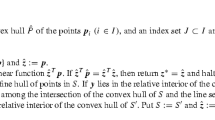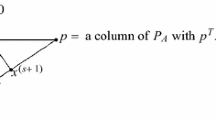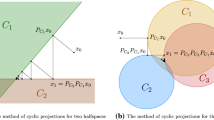Abstract
We propose methods to take advantage of specially-structured constraints in a variant of Karmarkar's projective algorithm for standard form linear programming problems. We can use these constraints to generate improved bounds on the optimal value of the problem and also to compute the necessary projections more efficiently, while maintaining the theoretical bound on the algorithm's performance. It is shown how various upper-bounding constraints can be handled implicitly in this way. Unfortunately, the situation for network constraints appears less favorable.
Similar content being viewed by others
References
K.M. Anstreicher, “A monotonic projective algorithm for fractional linear programming,”Algorithmica 1 (1986) 483–498.
E.R. Barnes, “A variation on Karmarkar's algorithm for solving linear programming problems,”Mathematical Programming 36 (1986) 174–182.
V. Chandru and B. Kochar, “A class of algorithms for linear programming,” manuscript, Department of Industrial Engineering, Purdue University, West Lafayette, IN (1985).
G.B. Dantzig,Linear programming and extensions (Princeton University Press, Princeton, NJ, 1963).
G.B. Dantzig, M.A.H. Dempster, and M.J. Kallio, eds.,Large scale linear programming (IIASA, Laxenburg, Austria, 1981).
G.B. Dantzig and R.M. Van Slyke, “Generalized upper bounding techniques,”Journal of Computer System Sciences 1(1967) 213–226.
G.B. Dantzig and P. Wolfe, “The decomposition algorithm for linear programming,”Econometrica 29 (1961) 767–778.
G. de Ghellinck and J.-Ph. Vial, “A polynomial Newton method for linear programming,”Algorithmica 1 (1986) 425–453.
D. Gay, “A variant of Karmarkar's linear programming algorithm for problems in standard form“,Mathematical Programming 37 (1987) 81–90.
P.E. Gill, W. Murray, M.A. Saunders, J.A. Tomlin and M.H. Wright, “On projected Newton barrier methods for linear programming and an equivalence to Karmarkar's projective method,”Mathematical Programming 36 (1986) 183–209.
C. Gonzaga, “A conical projection algorithm for linear programming,” manuscript, Department of Electrical Engineering and Computer Science, University of California, Berkeley, CA (1985).
G.W. Graves and R.D. McBride, “The factorization approach to large-scale linear programming,”Mathematical Programming 20 (1976) 91–110.
D. Jensen and A. Steger, private communication, Department of Applied Mathematics and Statistics, State University of New York at Stonybrook, Stonybrook, New York (1985).
S. Kapoor and P.M. Vaidya, “Fast algorithms for convex quadratic programming and multicommodity flows,” Proceedings of the 18th ACM Symposium on Theory of Computing (1986) 147–159.
N. Karmarkar, “A new polynomial time algorithm for linear programming,”Combinatorica 4 (1984) 373–395.
N. Karmarkar and L.P. Sinha, “Application of Karmarkar's algorithm to overseas telecommunications facilities planning,” paper presented at XII International Symposium on Mathematical Programming, Boston (1985).
L.S. Lasdon,Optimization theory for large systems (Macmillan, New York, 1970).
B.A. Murtagh,Advanced linear programming: computation and practice (McGraw-Hill, New York, 1981).
G. Rinaldi, “A projective method for linear programming with box-type constraints,”Algorithmica 1 (1986) 517–527.
L. Schrage, “Implicit representation of variable upper bounds in linear programming,”Mathematical Programming Study 14 (1975) 118–132.
L. Schrage, “Implicit representation of generalized variable upper bounds in linear programming,”Mathematical Programming 14 (1978) 11–20.
A. Steger, “An extension of Karmarkar's algorithm for bounded linear programming problems,” M.S. Thesis, SUNY at Stonybrook, New York (1985).
M.J. Todd, “An implementation of the simplex method for linear programming problems with variable upper bounds,”Mathematical Programming 23 (1982) 34–49.
M.J. Todd, “Improved bounds and containing ellipsoids in Karmarkar's linear programming algorithm,” to appear inMathematics of Operations Research.
M.J. Todd and B.P. Burrell, “An extension of Karmarkar's algorithm for linear programming using dual variables,”Algorithmica 1 (1986) 409–424.
R.J. Vanderbei, M.S. Meketon and B.A. Freedman, “A modification of Karmarkar's linear programming algorithm,”Algorithmica 1 (1986) 395–407.
Y. Ye and M. Kojima, “Recovering optimal dual solutions in Karmarkar's polynomial algorithm for linear programming,” to appear inMathematical Programming.
Author information
Authors and Affiliations
Additional information
Research supported in part by National Science Foundation Grant ECS-8602534, ONR Contract N00014-87-K-0212 and the US Army Research Office through the Mathematical Sciences Institute of Cornell University.
Rights and permissions
About this article
Cite this article
Todd, M.J. Exploiting special structure in Karmarkar's linear programming algorithm. Mathematical Programming 41, 97–113 (1988). https://doi.org/10.1007/BF01580755
Received:
Revised:
Issue Date:
DOI: https://doi.org/10.1007/BF01580755




